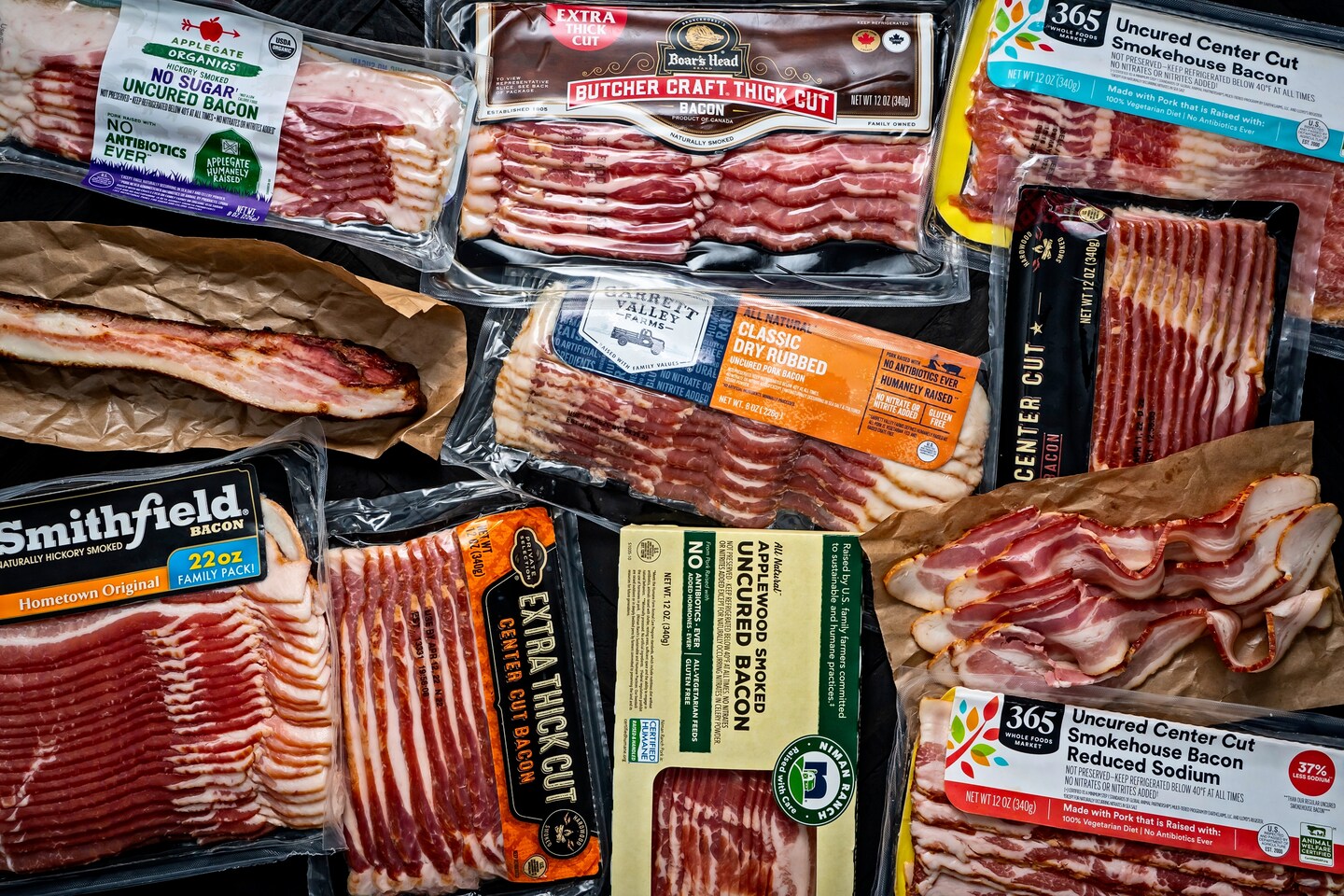If you’re in the same boat, here’s a handy guide to deciphering the labels so you can find your perfect package of bacon.
First, let’s define what “bacon” is. Though Canadian bacon (smoked, fully-cooked pork loin), guanciale (cured and sometimes smoked pork jowl), pancetta (cured but not smoked pork belly), beef bacon (not pork) and turkey bacon (again, a different animal) are all close facsimiles that may be suitable replacements when it comes to cooking and eating, they are not the real thing. For the purposes of this article, bacon is cured and smoked pork belly, also known as American bacon.
Curing. The first step in bacon production involves a preservation technique known as curing, where the food is mixed with salt (and sometimes sugar and other spices). There are three methods for curing bacon: Dry-curing, pumping and immersion. Dry-curing is the most traditional method, where the salt mixture is rubbed all over the belly. (The label typically says “dry rubbed.”) It’s a longer process that often results in more complex flavors, but it is typically more expensive because of the greater amount of time it takes. In pumping, a brine solution is injected directly into the meat, which speeds up the curing process, thus saving money and making it the method of choice for many mass-production manufacturers. Because of this extra moisture, the bacon is more likely to shrink as it cooks. “There is … an easy way to identify pumped bacon if you prefer to avoid it: They all contain ascorbate or sodium erythorbate in the ingredients list, chemicals the USDA mandates for safety reasons,” Niki Achitoff-Gray wrote in Serious Eats. Immersion, the least common of the three, is where the pork belly is submerged in brine.
Any bacon labeled “uncured” is a misnomer, because all bacon needs to be cured. Instead, it indicates whether the meat contains synthetic sodium nitrite or nitrites derived from “natural” ingredients. Nitrites and nitrates (which convert to nitrites during processing) are integral to the curing process, responsible for inhibiting bacterial growth while also contributing to bacon’s characteristic flavor and color.
The reason for the “uncured” labeling is that the USDA considers only four additives (sodium or potassium nitrate or sodium or potassium nitrite) as curing agents. However, the “uncured” label must be accompanied by an explanatory statement such as, “no nitrates or nitrites added except for those naturally occurring in ingredients such as celery juice powder, parsley, cherry powder, beet powder, spinach, sea salt, etc. .” Regardless of the source, “nitrite is nitrite, no matter where it comes from,” Tamar Haspel wrote for The Post, so this label doesn’t really mean anything when it comes to the end product.
Sodium. Lower or reduced sodium is pretty self-explanatory. But if you’re looking for specifics, this label indicates that it contains at least 25 percent less sodium than standard bacon. I don’t think I realized it at the time, but the pack of bacon I bought most recently before starting my research for this article was reduced sodium, and it still tasted sufficiently salty to me. (I plan to reach for it on purpose next time.) Given that Americans already consume more sodium than recommended, this made me wonder why all bacon isn’t made with less sodium. According to Jeffrey Sindelar, meat extension specialist at the University of Wisconsin at Madison: “The primary reason most bacon is not lower sodium is due to consumer preference. A majority of consumers expect bacon to have a certain amount of saltiness. So unless all bacon is lower in salt, some companies will lose market share if they reduce sodium (while others do not) since the majority still prefer ‘regular’ salt bacon. It’s all consumer driven.”
Tuxedo. “After curing, bacon is heated to 128 degrees and smoked using hardwood (hickory, apple wood, even pecan wood), liquid smoke, or a combination of both,” Joseph Cordray, an extension meat specialist at Iowa State University, relayed to Epicurious . The package may indicate the specific type of wood used; if not, it’s probably smoked over hickory.
Cut. Whole slabs of bacon can be purchased from the butcher and some grocery stores. The advantage of the slab is that you can cut it into whatever size you want (ie lardons). Regular packaged bacon is sliced about 1/16-inch thick, whereas thick-cut bacon is generally double that. Crispy bacon lovers should opt for thinner slices, while those that want some chew are better off with thicker cuts. And if you’re looking for less fat in your bacon, center-cut is the choice for you. It comes from pork belly cut close to the bone and has 25 to 30 percent less fat than standard bacon.
Some other terminology you might come across relate to the raising of the animals (pasture-raised, organic), whether sugar is used during curing, and general flavorings (maple, black pepper), but those are all pretty clear.
Now that you can decode the package labels, you’re ready to bring home the bacon.

